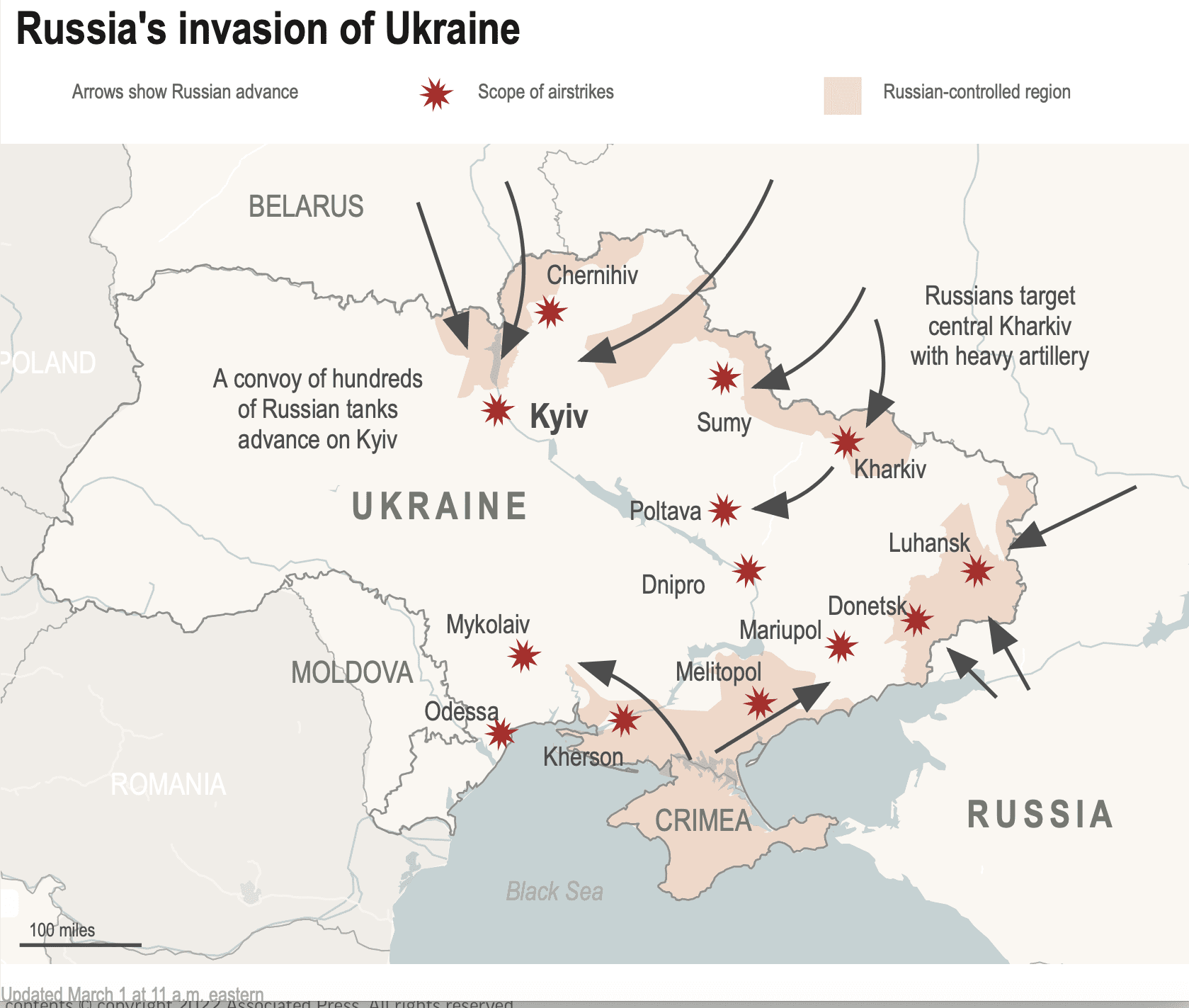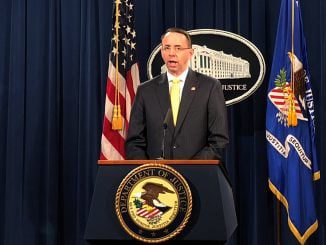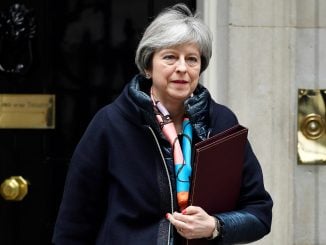The week before Russia attacked, a Ukrainian soldier peered through a periscope from the bottom of his trench. Mud seeped into his boots, his clothes and every crack in his gear as he walked the narrow space where he had spent his days for the past 10 months.
Zakhar Leshchyshyn was just 23. He had no memory of Ukraine as anything but a fully independent country. But now he was charged with helping to keep it that way, posted at Ukraine’s eastern front line since early last spring, when 100,000 Russian land and naval forces first encircled most of his country.
“These wars for territory are madness,” he said, “but probably this is human nature.”
Within days, Ukraine was engulfed by what the soldier in the trench saw as humanity’s dark impulse. The largest invasion Europe has seen since World War II has imperiled a young democracy while risking geopolitical instability far beyond the flashpoints of the new war.
In the conflict’s earliest days, each side managed to surprise the other. Russia unleashed a broader, larger invasion than almost anyone had predicted. And Ukraine, at least by U.S. and other Western accounts, has put up a more tenacious fight than many thought possible against the neighboring superpower. Fortunes can turn at any moment.
And so it has been for much of the past year. Russia alternately added and subtracted troops along the border, diplomacy seemed to make progress until it didn’t, Russian President Vladimir Putin seemed restrained, then not, then maybe, then not.
The path to war was convoluted — but also inexorable.
AN EARLY MARKER
It was back on March 31 of last year when the U.S. military raised an alert of a “potential imminent crisis” arising from Russian drills near the Ukrainian border. Not long after, Russian troops were ordered back to their permanent bases and the sense of alarm eased.
But those orders also required Russian troops to leave their heavy weaponry in Crimea and the Voronezh region bordering Ukraine, where it would already be in place if the forces returned — which they did. The reprieve was brief for Leshchyshyn’s unit and for Ukrainian President Volodymyr Zelenskyy, who had tweeted that the redeployment “proportionally reduces tension.”
Soon afterward, U.S. President Joe Biden agreed to meet Russian President Vladimir Putin in Geneva, a summit widely seen as a reward for suspending the drills. But by the end of summer, it was clear that Putin’s military plans were just getting started — even if they hadn’t quite taken shape yet.
When Zelenskyy visited Washington on Sept. 1, he came away with a pledge of $60 million in military aid.
ALARM IN WASHINGTON
The warnings from the Biden administration grew more pointed, and for the first time, U.S. intelligence officials started sharing specifics with Zelenskyy, European officials and eventually the public.
The White House realized that it was looking at the beginnings of what would probably turn into an enormous crisis by October. Officials were seeing a cascade of worrying intelligence strains, including troop movements, that suggested that Putin was looking to move on Ukraine.
Biden wanted Putin to know what he knew. He sent CIA Director Bill Burns to Moscow to warn Kremlin officials that the U.S. was fully aware of their troop movements. The White House made the calculation that the CIA chief’s travels, normally closely held, needed to be advertised far and wide.
“We wanted it to be known that he was there and understood by the Russians that we were starting to put them on notice and that we were going to do so publicly as well as privately,” said a senior administration official, who spoke on condition of anonymity to discuss internal deliberations.
In early December, national security officials shared information from an intelligence document with the press showing at least 70,000 Russian troops had massed near the Ukraine border. Much of the information could be gleaned independently but White House officials thought it was crucial to get the information out in the open “with U.S. government branding.”
So began a name-and-shame campaign in which the White House national security officials widely distributed a series of plots they contend Putin was weighing to set a pretext for an invasion of Ukraine.
Critics of U.S. intelligence — Russian officials among them — recalled past failures like the infamously false identification of weapons of mass destruction in Iraq nearly 20 years ago and the unexpectedly swift fall of Kabul last year.
In mid-November, a senior European diplomat spoke to The Associated Press on condition of anonymity to discuss confidential briefings. The diplomat was unconvinced by U.S. intelligence findings.
“We see the military build-up, at the same time, we don’t have any intelligence that there’s something like military action, or that Russians would be trying to become militarily active, so we don’t share this opinion, even though the Americans have said so,” the diplomat said. “We don’t see that there is intention on Putin’s part so far.”
At NATO, Germany blocked efforts to help Ukraine acquire military equipment. France and Germany objected to launching NATO’s crisis management system, but eventually relented at a NATO foreign ministers’ meeting in Latvia on Dec. 1. The move was essentially symbolic. The system is used to identify whether there is a crisis and launch preliminary planning to respond.
PUTIN’S GUESSING GAME
With some satisfaction, Putin said the military buildup has caused a “certain stress” in the West. “It’s necessary to keep them in that condition for as long as possible” to secure long-term security guarantees for Russia, he added.
He laid down his demands on Dec. 15: a ban on NATO membership for Ukraine and other ex-Soviet nations, a halt to the deployment of NATO weapons in those countries and a rollback of NATO forces from Eastern Europe. Meanwhile Russian troops kept arriving in Belarus to Ukraine’s north and on its eastern frontiers where heavy weaponry had been stockpiled since the spring.
Zelenskyy continued to play down the troop movements, noting that Ukraine had been facing threats from Russia and the separatists since 2014, when Russia annexed Crimea. On Jan. 10, Russia’s deputy foreign minister insisted there were “no plans, intentions or reasons to attack Ukraine.”
Two days later, the United States and NATO rejected Russia’s demands, and the movement of troops and weapons accelerated. Ukrainian government websites went down en masse, many displaying a warning from the suspected Russian-linked hackers: “Be afraid and expect worse.”
On Jan. 20, Russia announced sweeping naval drills off the coast of Ukraine and Biden said publicly he believed Russia planned an invasion.
On Feb. 4, Putin flew to Beijing, ostensibly for the Olympic Games although Russian athletes were banned from competing under their nation’s flag because of years of doping scandals. He and Chinese President Xi Jinping reaffirmed their support for each other’s foreign policy, including Russia’s backing of China’s claim to Taiwan.
The unspoken message: These two world powers were on the same page or a similar page, and China would not stand with most of the rest of the world against Putin’s designs on Ukraine.
MACRON TRIES
By then, 150,000 Russian troops had all but surrounded Ukraine and the United States had all but abandoned hope for a diplomatic solution. French President Emmanuel Macron attempted a last-ditch intervention. Flying first to Moscow to meet Putin, where the men sat across an absurdly long marble table, then to Kyiv, Macron tried fruitlessly to stave off war.
Publicly Macron said Putin assured him that Russia would not escalate the crisis. But privately he described the Russian leader as “more rigid, more isolated and fundamentally lost in a sort of ideological and security drift,” according to a senior French official.
The American warnings grew increasingly frantic, but life in Kyiv — Ukraine’s capital and its largest population center — continued as usual because, Zelenskyy insisted, Ukrainians would not yield to panic.
BLINKEN: ‘IT’S UNFOLDING’
On Feb. 17, U.S. Secretary of State Antony Blinken laid out “what the world can expect to see unfold. In fact, it’s unfolding right now.”
First, he said, there would be a staged provocation. Then would come a theatrical high-level meeting of the Russian government, followed by a proclamation that Russia must defend ethnic Russians in Ukraine. Then, he said, the attack would begin, with Kyiv a main target. Events would largely, perhaps fully, prove him right.
“We’ve been warning the Ukrainian government of all that is coming,” Blinken said, looking directly at the camera. “And here today, we are laying it out in great detail, with the hope that by sharing what we know with the world, we can influence Russia to abandon the path of war and choose a different path while there’s still time.”
On the night of Feb. 19, the separatist leaders released near-simultaneous videos announcing a general evacuation of women, children and the elderly. One of those pro-Russia separatists showed video of what he said was a car bomb exploding his personal vehicle — ostensibly, proof that Ukrainian troops were provoking a war.
The destroyed 4X4, however, was a suspiciously older model and metadata showed the videos were actually filmed three days earlier.
Putin summoned his top security officials and, in a dramatic pre-recorded meeting televised nationwide, asked them to explain one by one whether Russia should recognize the separatists and help them. One by one they agreed; there was little prospect that they would not.
Hours later, the Kremlin released yet another pre-recorded video, this time of Putin alone, cataloging Russian grievances against Ukraine, NATO, the United States and Europe. An independent Ukrainian nation, he said, was a fiction. Without evidence, he accused Ukraine of genocide and of seeking nuclear weapons. Russia, he insisted, had every right to attack such a country.
“I would now like to say something very important for those who may be tempted to interfere in these developments from the outside,” he added. “They must know that Russia will respond immediately, and the consequences will be such as you have never seen in your entire history.”
GLOBAL SUPPORT BUT NO TROOPS
The attack began before dawn on Feb. 24 — Thursday in Ukraine but, as it happens, still Wednesday in Washington.
It opened with the firing of more than 100 land- and sea-based missiles in the first hours, said a senior U.S. official who was not authorized to be identified and spoke on condition of anonymity. The official said the main targets of the air assault were barracks, ammunition warehouses, and 10 airfields. Russian ground forces began moving in from Belarus around noon.
Sanctions from the U.S. and Europe came down with hours, but Zelenskyy pleaded for more.
He spoke by phone with many foreign leaders. They expressed solidarity and offered help. None offered what he most wanted — troops to come to his country’s aid and a no-fly zone to protect Ukraine’s skies.
“This morning we are defending our state alone, as we did yesterday,” he said. “The world’s most powerful forces are watching from afar. We hear in our sky and see on our earth that this is not enough.”




